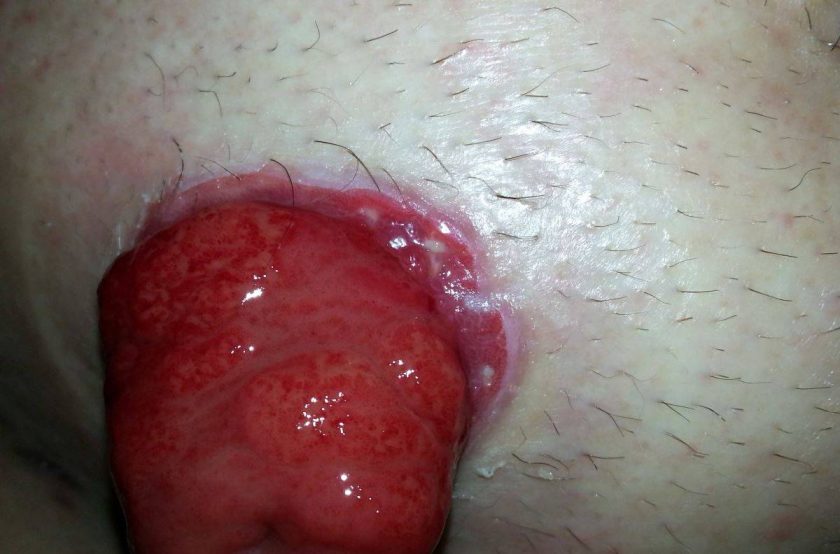The ideal appliance will fit in a way that protects your skin while also providing a durable, and secure fit. Unfortunately, not every ostomate can achieve this balance so easily, so many will experience a breakdown of skin around the stoma.
Video
By playing the above video you agree to YouTube's Terms and Conditions and Privacy Policy
This happened to me a short while after getting my ostomy, as my new stoma was still shrinking down from its swollen state.
I was quite inexperienced, so rather than change my appliance more often, I’d try to get 5+ day wear time, which meant that as my stoma became smaller, it left room for my output to eat away at my skin.
As you can see from the photos below, I had fairly deep erosion of the skin, and it hurt a lot. At the time, I had used the “crusting technique”, which involves putting stoma powder on the exposed, raw part of my skin, dust it off and apply a barrier using either barrier wipes or cavilon spray.
You do this a few times to build up protection on the skin, and to allow the wafer to stick to something other than the powder. This technique does work for many people, but it worked very slowly for me.
More recently, as I’ve been in between wafer samples, I began to get more breakdown of the skin.
I attempted to remedy this using the crusting technique, but I wasn’t getting the results I wanted; so instead, I opted to simply use a barrier ring without any powder or barrier wipes.
The results impressed me, and my skin has probably never looked that good around the stoma.

And here’s another example of how quickly this method can heal damaged skin:
Now, I continue to use a barrier ring when I notice more breakdown of the skin. I may continue to use them more regularly, but they are quite expensive and I’m not done trying new appliances that might offer a better fit.
Here’s a video showing how I change my appliance, including how I use barrier rings.
By playing the above video you agree to YouTube's Terms and Conditions and Privacy Policy
Caution: Before you change your routine, you should check with your stoma nurse first, unless you’re willing to experiment on your own.
INFO: If you’re interested in the “crusting technique” for healing peristomal skin, check out THIS article.
QUESTION: What techniques have you tried to heal up your skin?









Hi Eric,
I cannot thank you enough for the thoughtful and thorough stoma information that you share! I’ve had an ileostomy since February 5th of this year. I use the crusting technique, a barrier ring and a belt and continue to have skin issues around my stoma. Why do you think the lack of crust works? Is it because it allows the skin to breath? (Maybe you’ve addressed this and I simply missed it) Of course if the skin issues continue I will reach out to my fantastic stoma nurse. In the meantime I would like to try your recommendations!
Thank you again for all you do for our community!
Sincerely,
Ashby
Hi Ashby,
Skin issues can be difficult to identify, since there can be a wide range of causes.
Does your skin look like mine in the photos? Is it only a ring around the stoma, or is the damage/irritation under a larger area of the wafer?
Sometimes the crusting technique isn’t appropriate, and sometimes it is. The example in the article uses only the barrier ring without crusting, since the problem was more likely caused by skin erosion from output. The barrier ring basically stops further erosion, and helped to heal the skin.
But if the skin was being irritated by something else, then adding stoma powder + a barrier wipe will allow the skin to heal while also providing a good substrate for the appliance or barrier ring to stick.
It’s common to have more skin issues shortly after surgery. The stoma is often changing size (shrinking), so you’ll need to stay on top of sizing the hole in your wafer with every change. But also the skin hasn’t really adapted to the appliance, and the moisture that can be trapped under it.
If your skin looks very weepy (wet), and rash-like, it may be best to have a stoma nurse take a look. Anything from a sensitivity, allergy, or fungal infection would need to be handled differently.
Best to you!
I am a new osteomate. My home health-care ostomy RN is terrible. I have a double-barrel stoma. She has come one time. She rushed through it and my bag started leaking shortly after she left. The other care providers are not at all knowledgeable. I am very worried about the next wafer change. You have been a life-saver for me. I cannot thank you enough, but I am giving a small donation. Thank you so much, Eric, from the bottom of my heart.
Hi Sherry,
I’m so sorry that you’ve had that experience. Do you get a different nurse every visit, or is the same one?
Regular nurses generally don’t have the same knowledge to care for a stoma, especially a more complex one like a double-stoma.
Do you have access to, or can you request, a WOCN (wound, ostomy, and continence nurse)? They should be able to give you far better care.
Welcome Kailee! I’m a newbie ostomate myself, so many others with a wealth of experience here… But I’ll second @john68 suggestion to try a belt, if you haven’t already. I did find a huge improvement in my skin (due to fewer leaks) after I started wearing a belt. I try really hard to get a good fit, and I do use a ring under the wafer to help achieve that.